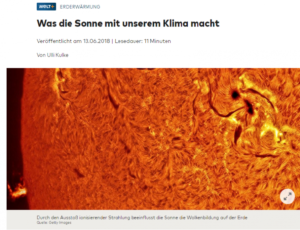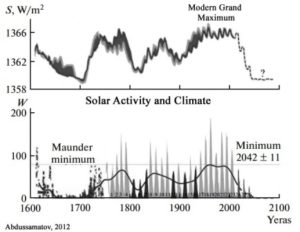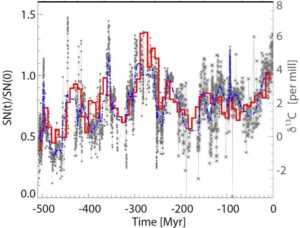by Ulli Kulke, June 29, 2018 in GWPF
Henrik Svensmark, head of solar research at Denmark’s Technical University in Copenhagen, is one of them. And he ventures far ahead in the climate debate, the research with perhaps the greatest significance of our time. His research is contested, of course. Nevertheless, Svensmark and his critics agree that the topic “sun” deserves more attention in climate research. The participants are particularly interested in the complex interplay between our central star and ionizing emissaries from the depths of the galaxy – “cosmic radiation”.
Svensmark says: “The climate is influenced more by changes in cosmic radiation than by carbon dioxide”. CO2 has an effect, of course, “but it is far less than most current climate models assume, and also less than the influence of cosmic radiation”. In his opinion, a doubling of the greenhouse gas in the atmosphere would cause an increase in global temperature of at most one degree, and not two degrees, as is now generally accepted.
In other words, the “climate sensitivity” of carbon dioxide is only half as high as assumed (…)

by Benny Peiser, March 17, 2018 in GWPF

by K. Richard, December 28, 2017 in ClimateChangeDispatch
During 2017, 120 papers linking historical and modern climate change to variations in solar activity and its modulators (clouds, cosmic rays) have been published in scientific journals.
It has been increasingly established that low solar activity (fewer sunspots) and increased cloud cover (as modulated by cosmic rays) are highly associated with a cooling climate.
In recent years, the Earth has unfortunately left a period of very high solar activity, the Modern Grand Maximum. Periods of high solar activity correspond to multi-decadal- to centennial-scale warming.
Solar scientists are now increasingly forecasting a period of very low activity that will commence in the next few years (by around 2020 to 2025). This will lead to climate cooling, even Little Ice Age conditions.
Thirteen recently-published papers forecasting global cooling are listed below.

by Willis Eschenbach, December 26, 2017 in WUWT
Last week, Anthony highlighted a study by Svensmark, Shaviv et al. in a post entitled New paper: The missing link between cosmic rays, clouds, and climate change on Earth. While some were enthusiastic about their claims, Leif Svalgaard and I were much more restrained in our opinions (…)
See also here
by H. Svensmark et al., December 19, 2017 in NatureCommunications
(…)In conclusion, a mechanism by which ions condense their mass onto small aerosols and thereby increase the growth rate of the aerosols, has been formulated theoretically and shown to be in good agreement with extensive experiments. The mechanism of ion-induced condensation may be relevant in the Earth’s atmosphere under pristine conditions, and able to influence the formation of CCN. It is conjectured that this mechanism could be the explanation for the observed correlations between past climate variations and cosmic rays, modulated by either solar activity or supernova activity in the solar neighborhood on very long time scales. The theory of ion-induced condensation should be incorporated into global aerosol models, to fully test the atmospheric implications.
See also here

by Dr David Whitehouse, December 19, 2017 in GWPF
The idea of a significant solar influence on climate change via cloud cover produced by cosmic rays has been proposed many times but it lacked conclusive experimental evidence as well as a detailed theoretical framework. Some have labelled the idea controversial with, at best, a weak effect. The principle is that cosmic rays – high-energy particles that traverse the galaxy from supernovae – knock electrons out of air molecules. This produces ions – electrically positive and negative molecules in the atmosphere. The ions help aerosols – clusters of mainly sulphuric acid and water molecules – to form and become stable against evaporation – a process is called nucleation. The problem was that small aerosols need to grow nearly a million times in mass in order to have an effect on cloud formation. Until now, it was not known how this could happen.
See also here
La géologie, une science plus que passionnante … et diverse




